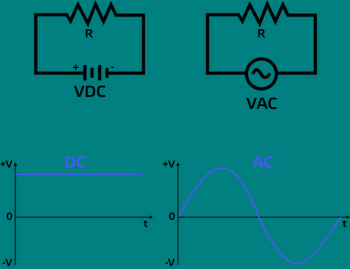What is the difference between VDC and VAC?
Alternating Current (AC) and Direct Current (DC) are the two types of electric currents that coexists in our daily life. They are both used for supplying power to the electrical devices. But they are very different. To make the difference between the two clear, we need some basics about electricity:
- Electric current (A) is the motion or flow of free electrons in a conducting material under the influence of potential difference. The material that contains free electrons is called conductors and they are used for conducting an electric current. So a conductor or electrical conductor is a material that allows electricity to flow through it.
- Voltage (V) or potential difference causes electric current to flow through a conductor (e.g. an electric wire). The free electrons existing in the conductor are excited when a voltage or potential difference is applied and they flow in a specific direction i.e. from high potential to the low potential. The high potential or voltage is denoted by positive (+) sign and the low potential is denoted by negative (–) sign and they form the polarity of the electric current. Based on the direction of motion of the electron or electric current, it is classified into two main types; Alternating Current (AC) and Direct Current (DC).
- Resistance (R) is a measure of how difficult it is for current to flow. Resistance is measured in units called ohms (Ω). The amount of current flowing in a circuit is affected by the resistance of that circuit. Each component in a circuit has a resistance.
- Resistance (R) is a measure of how difficult it is for current to flow. Resistance is measured in units called ohms (Ω). The amount of current flowing in a circuit is affected by the resistance of that circuit. Each component in a circuit has a resistance.
Both AC and DC describe types of current flow in a circuit. In direct current (DC), the electric charge (current) only flows in one direction. Electric charge in alternating current (AC), on the other hand, changes direction periodically.

VDC (Volts of Direct Current)
DC current flows in a constant direction. VDC (Volts Direct Current) is the voltage required to create a direct current (DC) circuit. Typical for VDC is that the high and low potential do not change position over time. DC voltage can be generated by batteries, power supplies that convert AC into DC and solar cells. 24 VDC is often used as a supply voltage for sensors, controllers and other devices that require a limited amount of power to operate. Power supplies that convert 230 VAC into 24 VDC offer increased safety. They automatically shut down in case of short circuit at the 24 VDC side. When the short circuit is removed, they continue to work normally. In case to many loads are connected, they shut down to avoid the risk of too high currents.
VAC (Volts of Alternating Current)
Unlike DC which flows continuously in a constant direction, AC currents periodically reverses their flow direction. For that reason, it is called Alternating Current. Since the direction of the current reverses periodically, the voltage polarity also reverses i.e. the high potential (+) and low potential (-) swaps together. Therefore, Alternating current is denoted by a wave (~) sign. The number of times electric current changes its direction in one second is called its frequency and it is commonly 50 Hz (Europe) or 60 Hz (US). Alternating Current is typically used to transport electrical power over large distances or to distribute power to larger electrical devices (e.g. electric motors).
